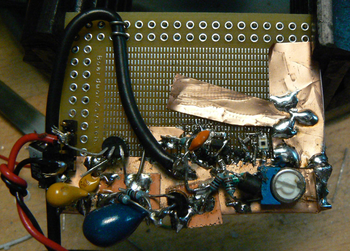
This is pretty small, because it has to be--those are microwave transistors, and will oscillate at the slightest provocation. The axial resistors and TO-92 parts are all for biasing---the actual amplifier is the part between the output coupling cap (the small orange thing in the middle) and the photodiode, which is the white square with the black middle at the right.
As discussed in medium-gory detail in this paper, laser noise cancellers can let you do shot-noise limited measurements at baseband with lasers that are as much as 70 dB noisier than that.
Sometimes the expert has to tell the client that their case probably won't hold up. This case was an excellent example: University of Cincinnati v. Crayola, Inc.
January 2013 - June 2015.
November 2009 to March 2015